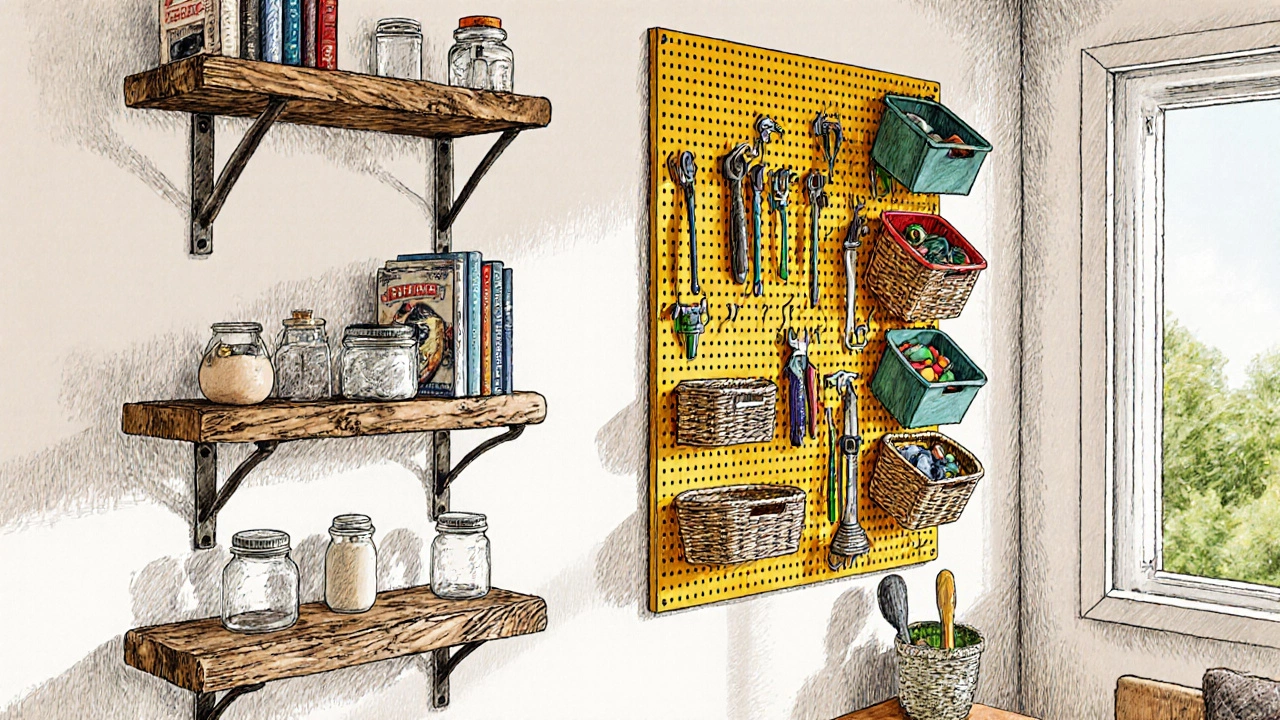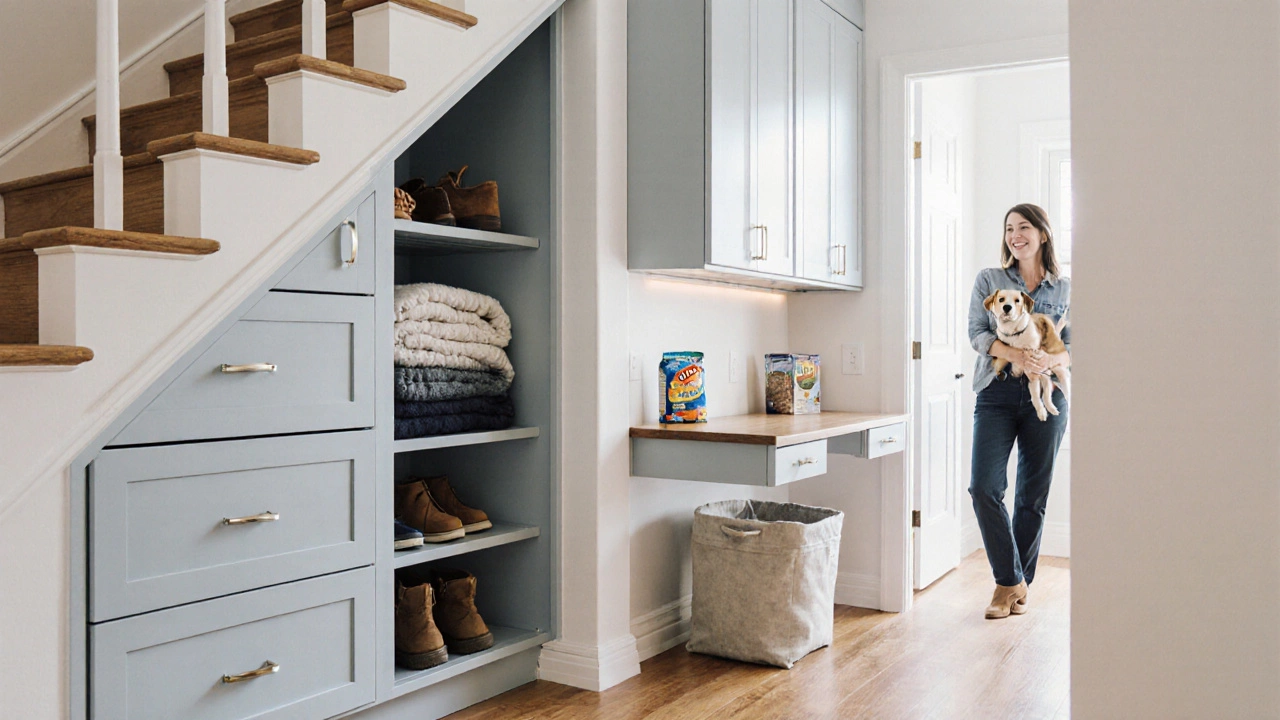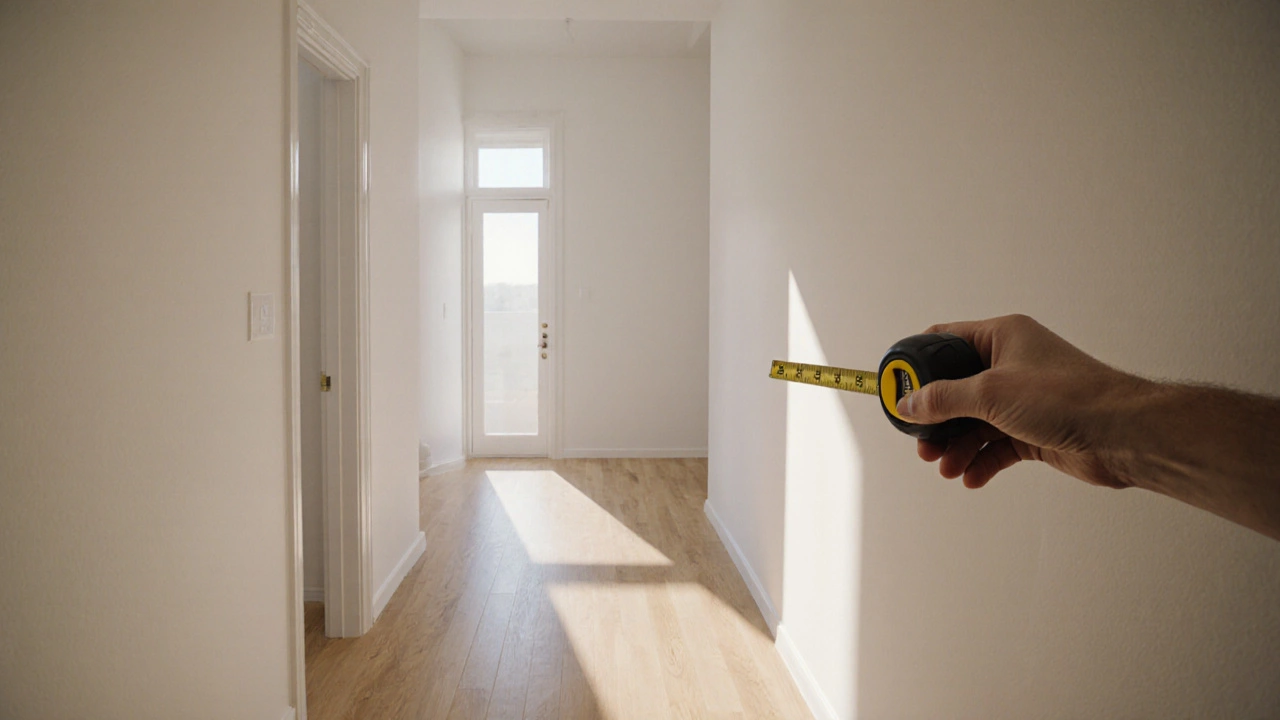When you move into a house that offers zero built‑in storage, the first thought is usually panic. DIY Home Storage Solutions are creative, low‑cost methods you can build yourself to turn any empty wall, corner, or awkward nook into usable space. By treating every surface as an opportunity, you can keep the clutter out and still enjoy a tidy home.
Assess the Space and Set Priorities
Start with a quick walk‑through. Grab a tape measure and note any dead spaces: under the stairs, above the kitchen sink, the space behind doors, and even the gap between the ceiling and a tall wardrobe. Write down what you need to store - books, shoes, kitchen gadgets, seasonal clothes - and rank the items by frequency of use. This step tells you which storage type will give you the biggest payoff.
Wall‑Mounted Shelves: Turning Empty Walls into Display Zones
Wall‑mounted shelves are sturdy panels that attach directly to studs or use heavy‑duty anchors, providing instant horizontal storage without taking floor space. Choose reclaimed wood for a rustic look or powder‑coated metal for a modern vibe. The key is to space the brackets 12‑16 inches apart to support heavier books or kitchenware. Install a shelf at eye level for everyday items and a higher one for decor you only need to see occasionally.
Pegboard Systems: Customizable Hooks and Bins
Pegboard is a perforated board that lets you attach hooks, baskets, and shelves in any arrangement you like. Paint it a bold colour to turn a utility room into a focal point. Because the holes are 1‑inch apart, you can mix small hooks for gardening tools with larger bins for craft supplies. The modular nature means you can re‑configure as your needs change, making it perfect for renters.
Under‑Stair Storage: Making the Most of Forgotten Nooks
Under‑stair cabinets are custom-built or prefabricated units that fit into the space beneath a staircase, turning a dead zone into useful storage. Measure the height, width, and depth of the opening. A simple plywood box with pull‑out drawers can hold shoes, cleaning supplies, or pet food. Add a hinged door with a magnetic catch for a seamless look. In houses with steep stairs, consider shallow drawers or sliding bins to avoid hitting the tread.

Fold‑Down Desks and Murphy‑Style Tables
Fold‑down desks are hinged work surfaces that fold up against a wall when not in use, freeing floor space for other activities. Use a sturdy backer board and install heavy‑duty hinges. Attach a small shelf above the desk to hold stationery. When folded, the desk becomes a slim panel that blends with other wall décor, ideal for tiny home offices.
Modular Shelving Systems: Flexibility for Every Room
Modular shelving consists of interchangeable units - cubes, ladders, and bins - that can be rearranged as your storage needs evolve. Pick a neutral finish and add fabric‑lined cubes for clothing, open cubes for books, and sealed bins for laundry. Because the pieces lock together, you can expand vertically or horizontally without tools, making it perfect for growing families.
Floating Cabinets: Sleek Storage Without the Bulk
Floating cabinets are wall‑mounted cupboards that appear to hover, offering concealed storage while keeping the floor clear. They’re especially handy in kitchens where cluttered countertops are a problem. Choose soft‑close hinges and add interior dividers for utensils, spices, or pantry items. The illusion of space makes a room feel larger, which is a psychological bonus for any small‑space dweller.
Storage Bins and Labels: The Low‑Cost Finish
Storage bins are portable containers made of plastic, fabric, or woven rattan that keep items tidy and easy to move. Pair them with a simple labeling system - a label maker or hand‑written tags - to find things in seconds. Clear plastic bins let you see the contents at a glance, while fabric bins add a soft texture to open shelves.

Comparison of Popular DIY Storage Options
| Solution | Installation Effort | Floor Space Used | Cost (Average UK £) | Best For |
|---|---|---|---|---|
| Wall‑mounted shelves | Medium - stud finding | None | 30‑80 | Books, décor |
| Pegboard system | Low - panel fix | None | 20‑50 | Tools, craft supplies |
| Under‑stair cabinets | High - custom carpentry | None (uses dead space) | 100‑250 | Seasonal items, shoes |
| Fold‑down desk | Medium - hinge install | None when folded | 50‑120 | Home office, kids' study |
| Modular shelving | Low - assembly only | Variable | 40‑150 | Living room, bedroom |
Pro Tips and Common Pitfalls
- Always locate wall studs before hanging heavy shelves - a stud finder costs less than £10 and saves you a collapse.
- Use a level for every installation; crooked shelves look cheap and can cause items to slide off.
- When building under‑stair cabinets, leave a 2‑inch clearance at the back to avoid rubbing against the ceiling.
- Choose uniform bin sizes for a clean visual line; mismatched containers create visual clutter even if the space is organized.
- Finish all wooden pieces with a low‑VOC sealant; it’s better for health and reduces off‑gassing in airtight rooms.
Bringing It All Together
Now that you have a toolbox of DIY storage ideas, the real work begins: mixing and matching to suit your home’s unique shape. Start with the biggest pain point - maybe the hallway closet - and apply a quick‑install pegboard. Next, fill the void under the stairs with a simple drawer unit. Keep adding layers, and soon you’ll realize the house feels larger, not because you added square footage, but because everything has a proper home.
Next Steps
- Make a list of the three rooms that need storage most.
- Pick one solution from each category above that fits the room’s style.
- Gather tools: drill, stud finder, level, screwdriver, measuring tape.
- Follow the step‑by‑step instructions for each project - you’ll finish most in a weekend.
- Label everything and enjoy the newfound space.
Can I install wall‑mounted shelves without a drill?
Yes, adhesive mounting strips designed for heavy loads can hold light shelves. For anything over 10 kg, a drill and screws into studs are safest.
What’s the cheapest way to create under‑stair storage?
Repurpose old wooden crates. Sand them, add hinges, and stack them to fit the stairwell. A few £10 supplies can turn a waste area into tidy cubbies.
Do pegboards hold heavy tools like power drills?
A standard steel pegboard can hold a drill if you use a sturdy hook and anchor it to a stud. For heavier items, consider a reinforced board or double‑layered pegboard.
How can I keep floating cabinets from looking too stark?
Add brushed‑metal handles, install interior LED lighting, or paint the cabinet front a muted colour that matches the wall. The effect is a sleek, built‑in feel.
Is it worth buying a modular shelving system or building my own?
If you enjoy DIY and have basic carpentry tools, building your own can save £30‑£70 and let you customise dimensions. Otherwise, a ready‑made system saves time and guarantees stability.

